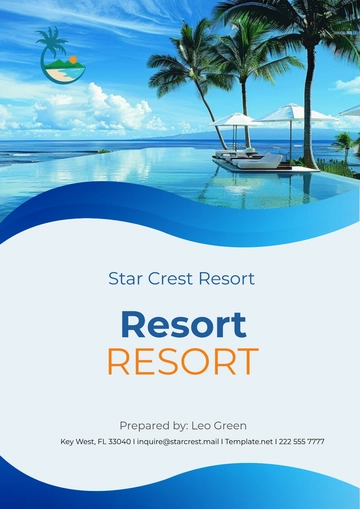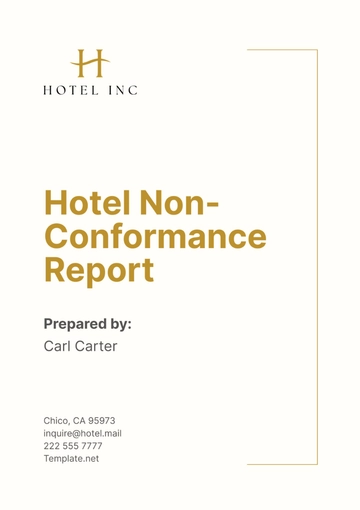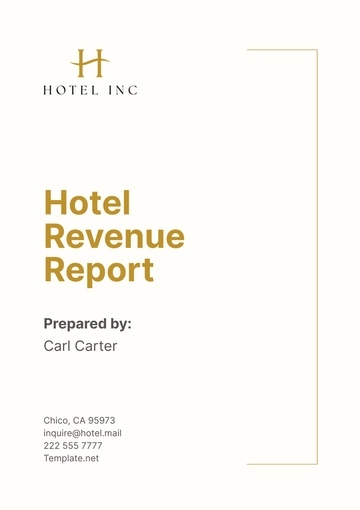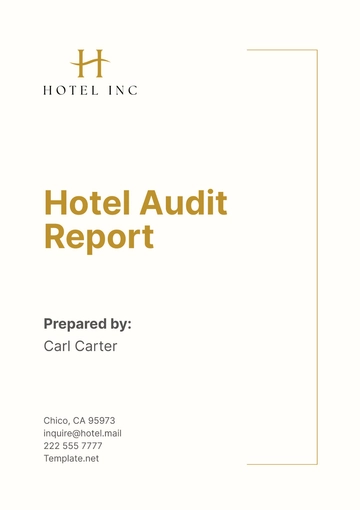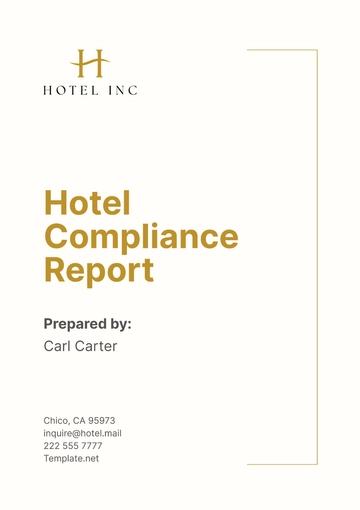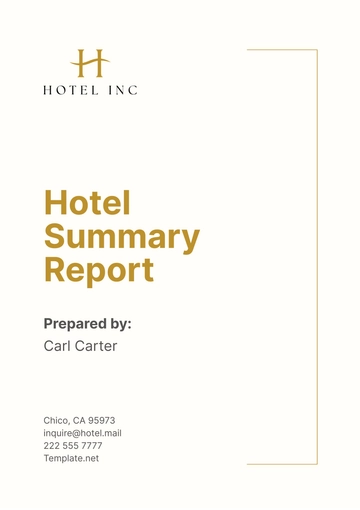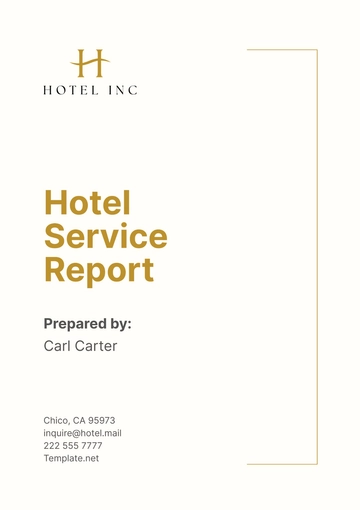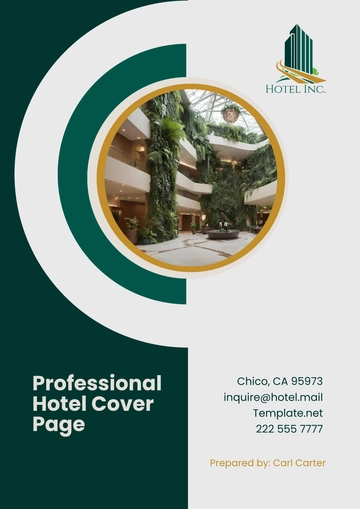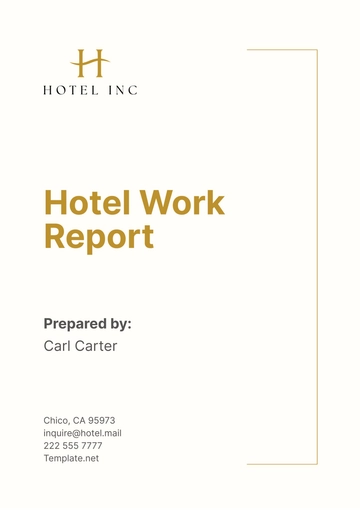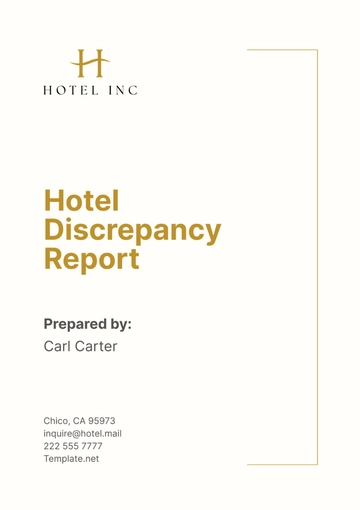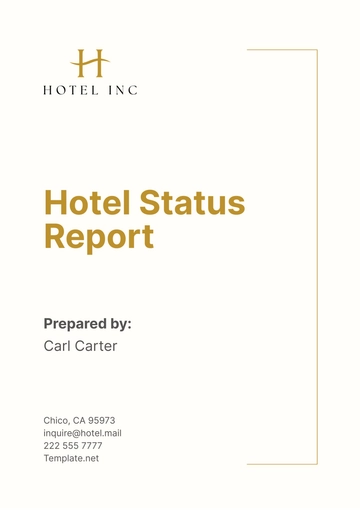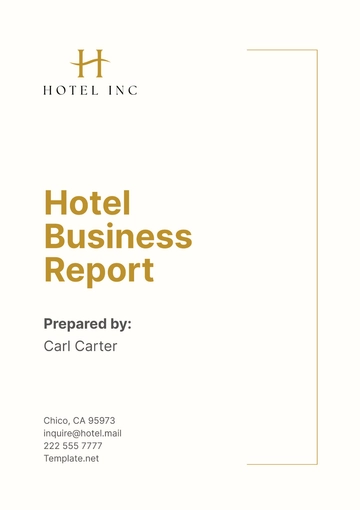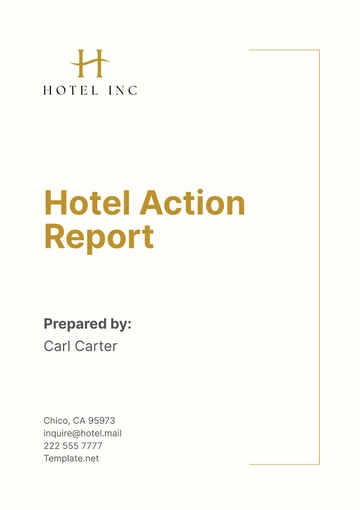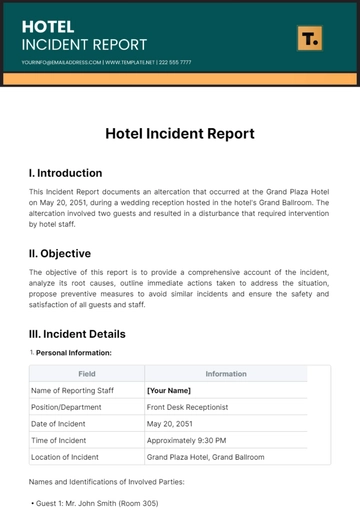Free Hotel Work Report
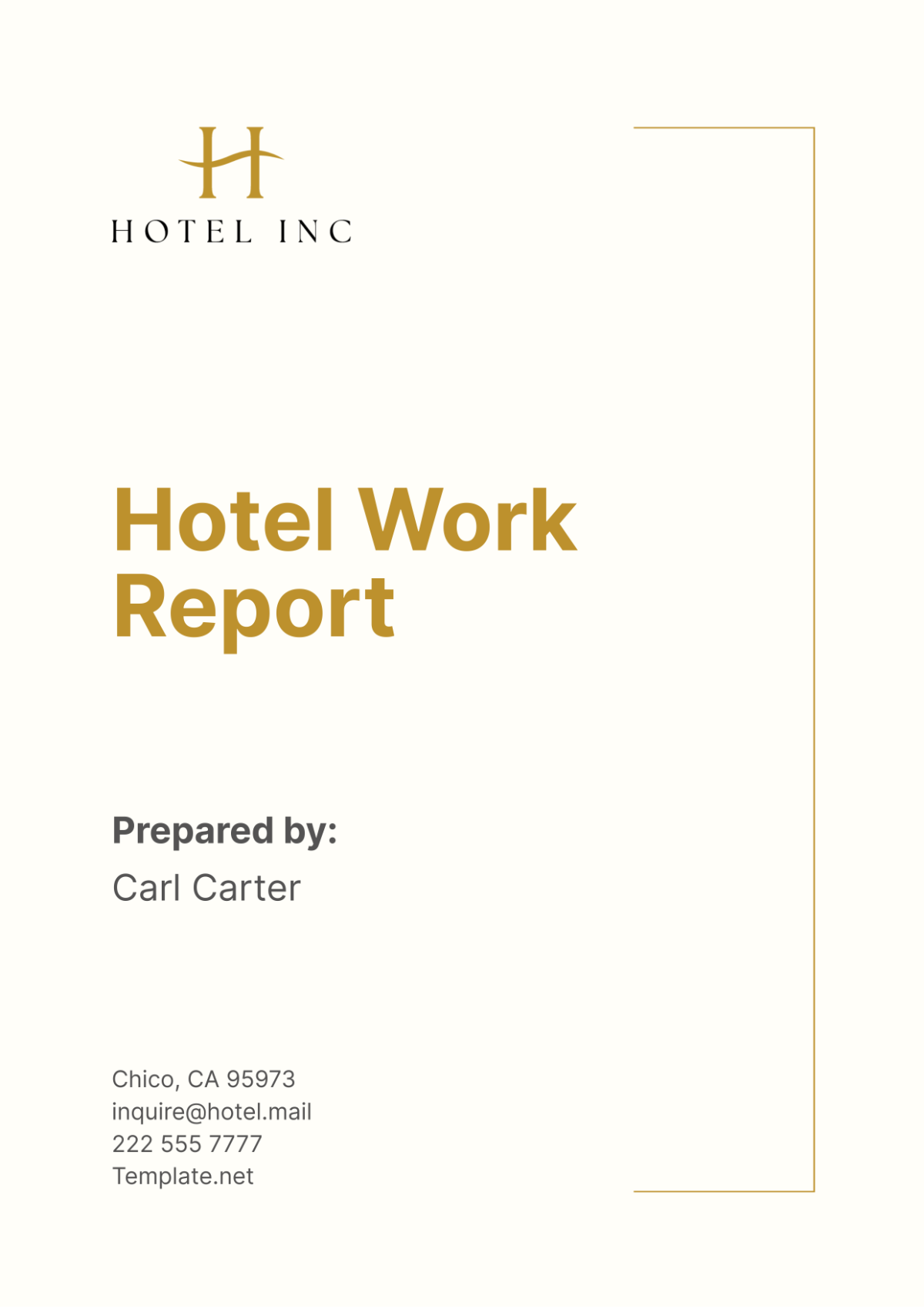
1. Executive Summary
This Hotel Work Report provides a comprehensive overview of the various tasks and activities undertaken within the period from January 1, 2050, to November 30, 2050, at [Your Company Name]. This period has been marked by significant strides in operational efficiency, guest satisfaction, and overall hotel performance. The report is structured to offer a detailed account of key performance metrics, highlighting areas where the hotel excelled and identifying opportunities for future improvement.
Key performance metrics such as occupancy rates, guest satisfaction scores, and revenue growth are meticulously analyzed to provide a clear picture of the hotel's performance over the past year. The report reveals that [Your Company Name] achieved an average occupancy rate of 85%, a notable increase compared to the previous year. Guest satisfaction scores also saw an upward trend, averaging 4.6 out of 5, reflecting our commitment to providing exceptional service. Additionally, the hotel experienced a 10% growth in revenue, driven by strategic marketing initiatives and enhanced service offerings.
Operational achievements are another focal point of this report. The successful completion of major projects, such as the lobby renovation and the introduction of a digital check-in system, has significantly improved the guest experience. The hotel also hosted several high-profile events, further cementing its reputation as a premier venue for international conferences and gatherings.
However, the report does not shy away from areas that require attention. It identifies specific challenges, such as increased response times for maintenance requests and the need for more comprehensive training programs for housekeeping staff. By addressing these areas, [Your Company Name] can continue to improve its operations and enhance overall efficiency.
This report provides a balanced view of the past year’s operations, celebrating successes while also acknowledging the areas that need improvement. It serves as a strategic tool for planning future initiatives aimed at sustaining growth and maintaining high standards of service.
2. Introduction
The purpose of this report is to document the ongoing projects and routine operations at [Your Company Name], covering the period from January 1, 2050, to November 30, 2050. This comprehensive documentation is crucial for several reasons. Firstly, it facilitates a better understanding of operational efficacy, allowing management to identify what works well and what does not. Secondly, it serves as a foundation for strategizing future improvements, ensuring that the hotel remains competitive and continues to meet the evolving needs of its guests.
By examining the data and outcomes from the past year, we can identify trends that indicate the hotel’s strengths and areas where there is room for growth. For instance, consistent high occupancy rates and positive guest feedback highlight the effectiveness of our current strategies. Conversely, areas with recurrent issues, such as maintenance delays or staff training gaps, indicate where additional focus and resources are needed.
This report also underscores the importance of continuous improvement. In the dynamic hospitality industry, staying ahead requires regular assessment and adaptation of our practices. By documenting both our successes and challenges, we create a roadmap for continuous improvement. This process not only enhances guest satisfaction but also boosts employee morale by creating a more efficient and supportive work environment.
Furthermore, the report highlights the interconnection between various operational aspects. For example, improvements in room service efficiency directly impact guest satisfaction scores, while effective marketing campaigns contribute to higher occupancy rates and revenue growth. Understanding these interdependencies helps in making informed decisions that benefit multiple facets of the hotel’s operations.
Overall, this report aims to provide a transparent and thorough account of [Your Company Name]'s operations over the past year. It is an essential tool for management, offering insights that inform strategic planning and operational adjustments. By leveraging the data and analysis presented in this report, [Hotel Name] can continue to thrive and set new benchmarks for excellence in the hospitality industry.
3. Project Overview
During the reporting period, several key projects were initiated and completed to enhance the guest experience and operational efficiency at [Your Company Name]. These projects were designed to address specific areas of the hotel's operations that would benefit from modernization and improvement. The following projects were particularly noteworthy:
1. Lobby Renovation Project
Objective: Modernize the lobby area for a more welcoming atmosphere.
Status: Completed in March 2050.
Details: The Lobby Renovation Project was aimed at transforming the first impression guests have upon entering the hotel. The project included a complete overhaul of the lobby's decor, installing new, contemporary furniture, enhancing lighting to create a warm and inviting atmosphere, and integrating digital check-in kiosks to streamline the check-in process. This renovation not only improved the aesthetic appeal of the lobby but also enhanced its functionality, allowing for quicker guest processing and reducing wait times. The inclusion of digital kiosks also catered to the growing preference for contactless interactions among guests.
2. Room Service Enhancement Program
Objective: Improve the quality and speed of room service.
Status: Ongoing; Expected completion by February 2051.
Details: The Room Service Enhancement Program is an ambitious initiative designed to elevate the hotel's room service standards. This program involves several key components: upgrading kitchen facilities to ensure faster preparation and delivery of meals, implementing advanced order management systems to streamline operations, and conducting extensive staff training to improve service quality. The training focuses on efficiency, accuracy in order taking, and enhancing the overall guest interaction experience. By February 2051, the hotel expects to see significant improvements in room service efficiency and guest satisfaction.
3. Energy Efficiency Upgrade
Objective: Implement energy-saving technologies throughout the hotel.
Status: Phase 1 completed in October 2050; Phase 2 to start in January 2051.
Details: The Energy Efficiency Upgrade project is part of the hotel's commitment to sustainability and cost reduction. Phase 1, completed in October 2050, focused on replacing all lighting with LED fixtures and upgrading the HVAC systems to more energy-efficient models. These changes have already begun to reduce the hotel's energy consumption significantly. Phase 2, scheduled to start in January 2051, will focus on implementing water conservation measures such as low-flow faucets and showerheads, as well as installing additional energy-efficient appliances. This phased approach ensures that the hotel can manage costs while progressively achieving greater energy efficiency.
4. Performance Metrics
The following performance metrics were tracked during the report period to gauge the hotel's operational success. These metrics provide a quantitative measure of the hotel's performance and highlight areas of strength and opportunities for improvement.
1. Occupancy Rate
Average: 85% from January to November 2050.
Comparison: This represents a 5% increase from the same period in 2049.
Analysis: The steady increase in occupancy rate indicates effective marketing strategies and enhanced guest experiences. This growth is attributed to the hotel's strategic initiatives, including improved facilities and services, which have attracted more guests and encouraged repeat stays.
2. Guest Satisfaction
Average Score: 4.6 out of 5 based on guest feedback surveys.
Analysis: The high guest satisfaction scores reflect positively on our service quality and guest experience. These scores were influenced by the successful implementation of new technologies, improved room amenities, and exceptional customer service. Continuous monitoring of guest feedback has allowed the hotel to address issues promptly and maintain high standards.
3. Revenue Growth
Increase: Achieved a 10% increase in revenue compared to the same period in 2049.
Drivers: The revenue growth can be attributed to higher occupancy rates, increased room rates, and successful marketing campaigns. Additionally, the introduction of new services and enhancements, such as the digital check-in system and upgraded room service, have contributed to higher guest spend per stay.
5. Operational Achievements
Significant operational achievements during the reporting period include:
International Conferences
Successfully hosted three international conferences with over 500 attendees each, enhancing our reputation as a premier event venue. These events showcased the hotel's capability to handle large-scale events efficiently, providing excellent service and facilities to international delegates.
Digital Check-In System
Introduced a new digital check-in system, reducing average check-in time by 40%. This system has significantly improved guest satisfaction by minimizing wait times and providing a seamless check-in experience. The technology also allowed staff to focus more on personalized guest interactions.
Customer Loyalty Program
Launched a customer loyalty program with over 1000 sign-ups within the first month. This program has fostered repeat business and enhanced guest loyalty by offering exclusive benefits and rewards to returning guests. The program's success is indicative of the hotel's strong relationship with its guests and its commitment to providing value-added services.
6. Areas for Improvement
While the hotel operations were generally successful, some areas need further attention to maintain and enhance service quality and operational efficiency.
1. Maintenance Requests
Issue: The average response time to maintenance requests increased from 30 minutes to 45 minutes.
Action Plan: Implementing a new maintenance request tracking system and increasing staff training to improve response times. The new system will provide real-time tracking of maintenance requests and ensure that staff can prioritize and address issues more efficiently.
2. Employee Training
Issue: There is a need for more frequent and comprehensive training for housekeeping staff to maintain quality standards.
Action Plan: Develop a continuous training program focusing on cleaning protocols, guest interaction, and the use of cleaning technology. This program will include regular workshops, hands-on training sessions, and evaluations to ensure that housekeeping staff are well-equipped to meet the hotel's high standards.
3. Guest Feedback
Issue: Some guests reported issues with Wi-Fi connectivity and in-room amenities.
Action Plan: Upgrade Wi-Fi infrastructure and conduct regular checks of in-room amenities to ensure everything is in working order. The hotel will also implement a proactive maintenance schedule to prevent future issues and enhance the overall guest experience.
By addressing these areas, [Your Company Name] can continue to improve its operations, enhance guest satisfaction, and maintain its competitive edge in the hospitality industry.
7. Conclusion
This report underscores the significant progress made in various operational areas at [Your Company Name] while also identifying key areas for improvement. Strategic initiatives are planned for the upcoming year to build on these achievements and address the challenges identified. Our continuous commitment to excellence and guest satisfaction drives our operational strategies and improvements.
Tables and Figures
The following tables provide a detailed summary of the key performance metrics tracked over the reporting period and an overview of the status of major projects undertaken to improve the operational efficiency and guest experience at [Your Company Name].
Table 1: Key Performance Metrics (January - November 2050)
This table highlights the essential performance metrics that were monitored throughout the year, comparing the data from 2050 to the previous year, 2049. These metrics include occupancy rate, guest satisfaction scores, and revenue growth, providing a clear picture of the hotel's operational success.
Metric | Value | Comparison (2049) |
|---|---|---|
Occupancy Rate | 85% | +5% |
Guest Satisfaction | 4.6/5 | +0.2 |
Revenue Growth | +10% | +10% |
Table 2: Project Status Overview
This table provides a snapshot of the major projects initiated and completed during the reporting period. It details the objectives, current status, and completion dates of each project, offering insights into the hotel's efforts to enhance its facilities and services.
Project Name | Objective | Status | Completion Date |
|---|---|---|---|
Lobby Renovation Project | Modernize lobby | Completed | March 2050 |
Room Service Enhancement | Improve room service quality/speed | Ongoing | February 2051 |
Energy Efficiency Upgrade | Implement energy-saving technologies | Phase 1 Complete | October 2050 (Phase 1) |
January 2051 (Phase 2) |
Contact Information
Prepared by:
[Your Name]
Email:
[Your Email]
Company Name:
[Your Company Name]
Company Number:
[Your Company Number]
Address:
[Your Company Address]
Company Email:
[Your Company Email]
Website:
[Your Company Website]
Social Media Handles:
[Your Company Social Media]
[Your Report Date]
- 100% Customizable, free editor
- Access 1 Million+ Templates, photo’s & graphics
- Download or share as a template
- Click and replace photos, graphics, text, backgrounds
- Resize, crop, AI write & more
- Access advanced editor
Optimize productivity and streamline reporting processes in your hotel with Template.net's Hotel Work Report Template. Capture and track daily activities, achievements, and challenges effortlessly. Fully customizable with our AI editor tool, this template ensures flexibility to adapt to your specific reporting requirements. Enhance transparency and communication within your team with Template.net.
You may also like
- Sales Report
- Daily Report
- Project Report
- Business Report
- Weekly Report
- Incident Report
- Annual Report
- Report Layout
- Report Design
- Progress Report
- Marketing Report
- Company Report
- Monthly Report
- Audit Report
- Status Report
- School Report
- Reports Hr
- Management Report
- Project Status Report
- Handover Report
- Health And Safety Report
- Restaurant Report
- Construction Report
- Research Report
- Evaluation Report
- Investigation Report
- Employee Report
- Advertising Report
- Weekly Status Report
- Project Management Report
- Finance Report
- Service Report
- Technical Report
- Meeting Report
- Quarterly Report
- Inspection Report
- Medical Report
- Test Report
- Summary Report
- Inventory Report
- Valuation Report
- Operations Report
- Payroll Report
- Training Report
- Job Report
- Case Report
- Performance Report
- Board Report
- Internal Audit Report
- Student Report
- Monthly Management Report
- Small Business Report
- Accident Report
- Call Center Report
- Activity Report
- IT and Software Report
- Internship Report
- Visit Report
- Product Report
- Book Report
- Property Report
- Recruitment Report
- University Report
- Event Report
- SEO Report
- Conference Report
- Narrative Report
- Nursing Home Report
- Preschool Report
- Call Report
- Customer Report
- Employee Incident Report
- Accomplishment Report
- Social Media Report
- Work From Home Report
- Security Report
- Damage Report
- Quality Report
- Internal Report
- Nurse Report
- Real Estate Report
- Hotel Report
- Equipment Report
- Credit Report
- Field Report
- Non Profit Report
- Maintenance Report
- News Report
- Survey Report
- Executive Report
- Law Firm Report
- Advertising Agency Report
- Interior Design Report
- Travel Agency Report
- Stock Report
- Salon Report
- Bug Report
- Workplace Report
- Action Report
- Investor Report
- Cleaning Services Report
- Consulting Report
- Freelancer Report
- Site Visit Report
- Trip Report
- Classroom Observation Report
- Vehicle Report
- Final Report
- Software Report
